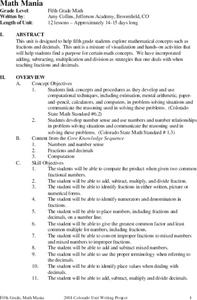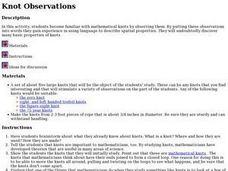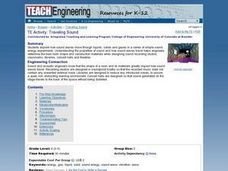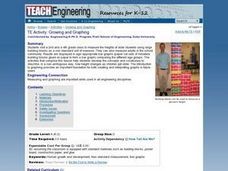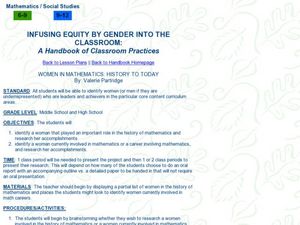Teach Engineering
Photosynthesis—Life's Primary Energy Source
Wouldn't it be great if you could produce your own food? Scholars learn about the processes of photosynthesis and cellular respiration in plants. They consider how to use photosynthesis as a model of an efficient system and how to apply...
Teach Engineering
The Challenge Question
A research position becomes a modeling job. The introductory lesson in a series of nine presents the challenge of analyzing a set of bivariate data. The class brainstorms what the data may represent. Pupils must decide what is needed to...
Teach Engineering
Exploring Energy: Kinetic and Potential
The potential of the energy in the class is moving. The third segment in a six-part unit on energy provides a deeper understanding of kinetic and potential energy. Learners understand the relationship between mass, speed, and energy and...
Curated OER
Math Mania
Fifth graders review adding, subtracting, multiplication and division of fractions and decimals through a variety of activities and exercises.
Curated OER
Math: Knot Observations
Students discover the importance of knots to mathematicians in developing scientific theories. In small groups, they examine knots and make obeservations about them. Students discuss the ways to distinguish knots and make lists of...
Curated OER
Catch as Catch Can
Students investigate insects. In this insect analysis instructional activity, students catch insects using nets they make. They identify the insects they catch and create a chart to show the numbers and varieties. This instructional...
Curated OER
Dribbling Math Challenge
Students practice foot dribbling and hand dribbling with control. In addition it helps to reinforce math concepts.
Curated OER
Bulbs & Batteries Side by Side
Students build parallel circuits, exploring how they function and looking at their unique features. They describe how current changes when batteries are added in parallel or removed from a parallel arrangement, demonstrate the process of...
Curated OER
GPS Scavenger Hunt
Students go on a GPS scavenger hunt. They use GPS receivers to find designated waypoints and report back on what they found. They compute distances between waypoints based on the latitude and longitude, and compare with the distance the...
Curated OER
Science: Reading a Compass
Students demonstrate how to take bearings using a compass. In pairs, they select objects in the classroom then write down its first initial and bearing. They exchange papers and try to disciver their partner's object.
Curated OER
Endocrine Excitement!
Students are divided into a group of hormones and a group of receptors. The hormones have to find their matching receptors, and the pair, once matched, perform a given action. This activity helps students examine the specificity of...
Curated OER
Traveling Sound
Young scholars explore how sound waves move through liquids, solids and gases in a series of simple sound energy experiments. They describe how sound needs molecules to move and that changing the medium that it travels through changes...
Curated OER
Light Plants and Dark Plants, Wet Plants and Dry Ones
Young scholars plant sunflower seeds in plastic cups, and once germinated, these are exposed to different conditions of light levels and/or soil moisture contents. Students measure growth of the seedlings every few days using...
Curated OER
Growing and Graphing
Pupils visit a 2nd and a 4th grade class to measure the heights of older students using large building blocks as a non-standard unit of measure. They can also measure adults in the school community. Results are displayed in...
Curated OER
GPS Art
Students design their own logo or picture and use a handheld GPS receiver to map it out. They write out a word or graphic on a field or playground, walk the path, and log GPS data. The results display their "art" on their GPS receiver...
Lesson This!
Math Lesson Plan: Bingo Dabbing by 5's
Those extra large markers or "bingo dabbers" are so much fun to play with! Let learners use them to dab groups of five and practice skip counting by 5s to 100 or to 200.
Curated OER
Visual Models of Solutions and Concentrations
Students model solutions with beakers of colored glass or plastic spheres. In this solutions lesson, students use beakers of colored spheres to represent pure substances. They mix the spheres to demosntrate solutions. They discuss...
Curated OER
WOMEN IN MATHEMATICS: HISTORY TO TODAY
Students explore women who have played important roles in the history of math.
Curated OER
Women In Aviation
In this aviation lesson, students take an electronic field trip to the Aviation Museum of Kentucjy. In the process the lesson looks at women in aviation history. The focus is upon how they could be considered heroes or role models. The...
Curated OER
We Are Alike, We Are Different:A Focus on Japan
First graders develop a connection with students in a first grade classroom in Japan. They begin to develop a curiosity about Japan--the landscape, the people, and their culture, while developing an understanding of the Five Themes of...
Curated OER
Importance of Fresh Vegetables and Fruits in Our Diets
Students explore the importance of fruits and vegetables in our diets. In this science lesson, students discuss various types of fruits and vegetables. Students play the good health=good diet game. Students discuss types of fruits and...
Curated OER
Functions and Statistics: International Space Station: Up to Us
Students explore how the International Space Station was built and how it provides first-hand experiences with the space program. They view the NASA engineers discussing the major components of the International Space Station, their...
Curated OER
Simply Symmetry
Young scholars are introduced to the concept of symmetry by examining different shapes and folding them into equal halves. They work in small groups focusing on finding the lines of symmetry of one specific shape. A symmetry booklet is...
Curated OER
Here's the Pitch
Students define pitch, measure varying amounts of water into containers, make predictions about the sounds made when striking the containers, put containers in order from highest to lowest pitch, and create their own sound patterns with...



